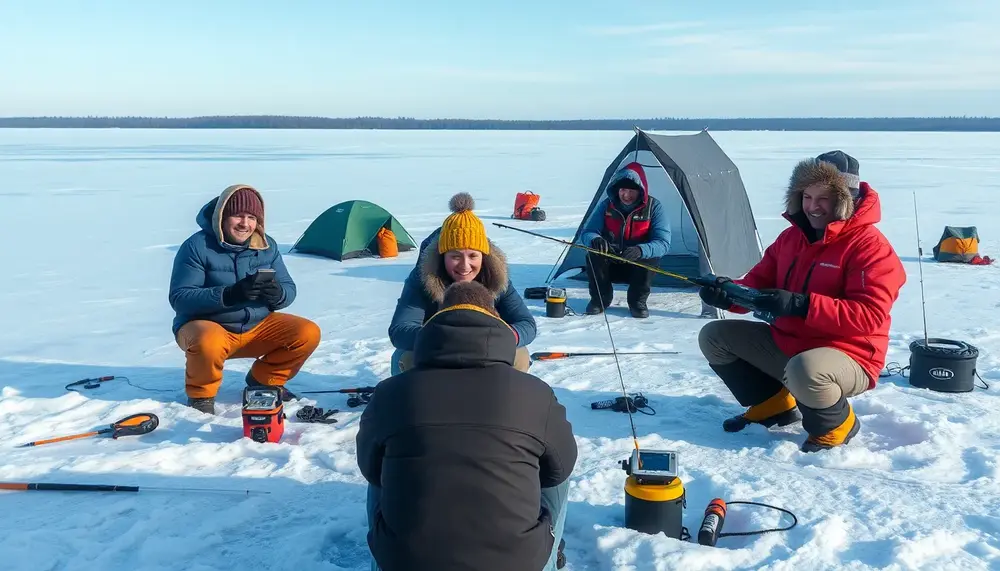Table of Contents:
How Livescope is Transforming Ice Fishing Success
Imagine drilling a hole in the ice and, instead of waiting blindly, you actually see fish swimming below—live, in real time. That’s not science fiction anymore. Livescope technology has flipped the script for ice anglers who want more than guesswork. The secret sauce? It’s the instant, moving sonar image, letting you track fish, structure, and even your lure’s dance beneath the frozen surface.
With Livescope, the days of random hole-hopping are pretty much over. Anglers can now pinpoint schools of perch or walleye, observe their behavior, and adjust tactics on the fly. It’s almost like having x-ray vision for the ice. You’re not just reacting—you’re strategizing, based on live feedback. Subtle changes in jigging? You’ll see if fish react or ignore you. That level of feedback is a total game-changer, especially when conditions are tough or fish are finicky.
What’s wild is how this technology also helps avoid wasted time. Instead of sitting over empty water, you’re always on the move, guided by real-time data. This leads to more efficient sessions and, let’s be honest, a lot more action. Plus, the technology is modular and portable, so you can adapt your setup to different ice conditions or target species. For anyone serious about ice fishing, Livescope isn’t just an upgrade—it’s a whole new way to experience the sport.
Key Benefits: What Makes Livescope Indispensable for Ice Anglers
Livescope stands out for ice anglers not just because it’s flashy tech, but because it delivers practical, real-world advantages that traditional sonar simply can’t match. Here’s what makes it truly indispensable:
- Instant Feedback on Fish Behavior: You can watch, in real time, how fish respond to different lures, colors, or jigging techniques. This lets you adapt your approach instantly, which can be the difference between a slow day and a record catch.
- Efficient Hole Selection: Instead of drilling dozens of holes hoping to land on a school, you scan before you even drop a line. This means less wasted effort and more time actually fishing.
- Enhanced Safety: By understanding the underwater structure and ice thickness in detail, you reduce the risk of fishing over unsafe or unpredictable areas—an often overlooked but critical benefit.
- Group Fishing Coordination: Anglers can share real-time data with others on the ice, helping groups spread out and cover more ground without overlapping efforts.
- Year-Round Versatility: Many Livescope systems can be adapted for open water use, making your investment valuable beyond just the winter months.
These benefits combine to make Livescope not just a gadget, but a strategic tool that redefines what’s possible on the ice. For anglers chasing efficiency, safety, and a higher catch rate, it’s quickly becoming a must-have.
Typical Livescope Ice Fishing Setups: A Component Overview
When assembling a Livescope setup for ice fishing, each component serves a specific purpose, and choosing the right combination can make a noticeable difference in performance and convenience. Let’s break down the typical elements found in a well-rounded Livescope kit for the ice:
- Sonar Transducer: The heart of the system, this device emits and receives sonar signals, delivering the crisp, live images that set Livescope apart. Specialized ice transducers are designed to function optimally in cold, harsh environments.
- Portable Display Unit: Usually a high-resolution, sunlight-readable screen, the display is compact enough for easy transport yet large enough to interpret detailed sonar returns. Some models feature touch controls for quick adjustments with gloved hands.
- Power Source: Lithium batteries are common, prized for their light weight and long runtime. Many setups include insulated battery bags to keep power consistent even in subzero temperatures.
- Mounting System: Adjustable poles or telescopic arms allow precise placement of the transducer in the ice hole. Some anglers opt for quick-release mounts to switch locations rapidly as fish move.
- Protective Carry Case: Custom-fit cases or rugged bags keep all components organized and shielded from snow, slush, and bumps during transport across the ice.
- Accessory Add-ons: Optional extras like cable management clips, glare shields for the display, or backup batteries can be tailored to individual fishing styles and trip lengths.
Every element is chosen for reliability and ease of use in extreme winter conditions. The modular nature of these setups means you can start simple and expand as your needs or ambitions grow.
Customization Options: Matching Livescope To Your Needs
Finding the right Livescope setup isn’t a one-size-fits-all affair—ice anglers have unique preferences, budgets, and fishing styles. Customization is where Livescope really shines, letting you fine-tune your gear for maximum comfort and performance.
- Display Choices: You can select from various screen sizes and resolutions. Larger displays offer more detail, but smaller units are lighter and easier to pack if you’re trekking long distances on foot.
- Battery Configurations: Some anglers prefer lightweight batteries for quick outings, while others opt for high-capacity power packs to last through marathon sessions or extreme cold. Swappable battery systems add flexibility for multi-day trips.
- Mounting Flexibility: Adjustable poles, quick-release arms, and custom brackets let you position the transducer exactly where you want it. This is especially handy if you fish from both shelters and open ice, or need to adapt to different ice thicknesses.
- Modular Add-ons: It’s possible to add or upgrade components over time—like integrating GPS modules, wireless networking for sharing data, or enhanced mapping features for advanced scouting.
- Transport Solutions: Choose between hard cases for maximum protection or soft bags for lightweight mobility. Some setups even offer backpack-style carrying for hands-free travel.
Ultimately, the modular approach means you’re not locked into a single configuration. You can build a system that grows with your ambitions, ensuring your investment remains relevant as your ice fishing evolves.
Practical Example: Real-Time Fish Targeting under Ice
Picture this: You’re on a frozen lake, bundled up, and you’ve just drilled a fresh hole. Instead of guessing what’s below, you lower your Livescope transducer and instantly spot a cluster of fish holding tight to a submerged log. You see, in real time, their silhouettes shifting and darting as your lure drops into view.
Now, here’s where things get interesting. You start jigging, and you can literally watch the fish react—one turns, approaches, hesitates. You slow your movement, then give a tiny twitch. That’s the trigger. The fish charges and, right before your eyes, you see the strike on the screen before you even feel it on your rod. That’s not just exciting; it’s a tactical edge.
Let’s say the fish lose interest. Instead of waiting, you immediately move to a new spot where the sonar shows more activity. No wasted time, no guesswork. Or maybe you notice the fish are suspended at a certain depth, so you adjust your lure to hover right in their strike zone. The ability to fine-tune your approach, second by second, means you’re always fishing smart—not just hard.
With Livescope, you’re not just reacting to what happened; you’re actively shaping the outcome, making real-time decisions that turn a slow day into a productive one. It’s like having a live window into the underwater world, and it changes everything about how you target fish beneath the ice.
Expert Tips for Selecting and Comparing Livescope Ice Fishing Bundles
Choosing the right Livescope bundle for ice fishing isn’t just about grabbing the latest kit off the shelf—it’s about matching features to your specific needs and fishing style. Here’s how seasoned anglers approach the decision:
- Evaluate Display Readability: Not all screens handle glare, frost, or low-light equally. Prioritize anti-glare coatings and backlit displays if you fish at dawn, dusk, or on bright snowfields.
- Check Real-World Battery Endurance: Manufacturer specs can be optimistic. Look for independent reviews or user forums where anglers share actual run times in subzero conditions.
- Assess Cold-Weather Durability: Some bundles use reinforced cables, weather-sealed connectors, or impact-resistant cases. These details matter when gear gets tossed around on ice or in sleds.
- Compare Transducer Versatility: If you plan to use your system in open water too, ensure the transducer is compatible with both ice and boat mounts. This maximizes off-season value.
- Analyze Included Accessories: Don’t get dazzled by flashy extras you’ll never use. Instead, focus on practical add-ons like quick-mount arms, spare batteries, or cable management clips that fit your fishing routine.
- Research After-Sale Support: Reliable customer service and warranty coverage can save headaches if something fails mid-season. Some brands offer faster repairs or local service centers—worth considering for frequent anglers.
- Price vs. Upgrade Path: Sometimes, a mid-range bundle with modular options offers better long-term value than a top-tier, all-in-one kit. Think about what you’ll actually use and whether you can upgrade components later.
Pro tip: Use side-by-side comparison tools and check for recent field tests or group reviews from trusted angling communities. This helps you spot subtle differences that might not be obvious in spec sheets, ensuring you invest in a bundle that genuinely fits your ice fishing ambitions.
Conclusion: Unlock New Levels of Efficiency and Fun with Livescope
Livescope isn’t just about catching more fish—it’s about transforming the entire ice fishing experience into something more dynamic, interactive, and, frankly, a lot more fun. What’s often overlooked is how this technology encourages experimentation. Anglers are now empowered to try unconventional tactics, test new lure presentations, or even collaborate with friends in real time, sharing discoveries across the ice. The learning curve becomes a shared adventure, not a solitary struggle.
Another unexpected benefit? The data you gather over a season can be used to build a personal archive of hotspots, fish behaviors, and seasonal patterns. This means each trip becomes more informed than the last, letting you refine your approach year after year. For those who enjoy the analytical side of fishing, Livescope turns every outing into a mini research project—where the results are immediate and the insights genuinely useful.
In short, Livescope doesn’t just raise your catch rate; it opens the door to a more engaging, social, and knowledge-driven way to enjoy ice fishing. The technology is not just a tool—it’s a catalyst for creativity and community on the ice.
FAQ: Real-Time Ice Fishing with Livescope Technology
What makes Livescope different from traditional ice fishing sonar?
Unlike traditional sonar, Livescope provides real-time, moving images of fish, your lure, and structure under the ice, giving anglers instant feedback and allowing more precise, strategic fishing.
How does Livescope increase success rates for ice anglers?
Livescope lets you see fish behavior in real time, adjust your tactics instantly, and find active fish quickly, which leads to more efficient sessions and an increased catch rate.
What key components are included in a typical Livescope ice fishing setup?
A standard setup includes a sonar transducer, portable display, battery, mounting system, and a protective carry case. Additional accessories and upgrades can be added for customization.
Can Livescope setups be customized for different fishing needs?
Yes, anglers can choose between various display sizes, battery capacities, mounting options, and add-ons to tailor their system to their unique preferences, mobility needs, and budget.
How does Livescope improve group and year-round ice fishing?
By sharing live data, groups can coordinate effectively and cover more ice without overlap. Many Livescope systems are also adaptable for open-water fishing, extending their usefulness beyond the ice season.







